Wintergreen plants, like Gaultheria procumbens, are common in Alaska’s green spaces. They raise questions about their edibility. The leaves and berries of these plants have been used by Indigenous communities for their health benefits. But, it’s crucial to be careful when eating them.
The dark green, glossy leaves taste good but be cautious. They contain methyl salicylate, which can affect some people. The berries are safe to eat in small amounts. This introduction will lead to a deeper look at wintergreen plants in Alaska, including their health benefits and safe eating practices.
Table of Contents
Understanding Wintergreen Plants in Alaska
Wintergreen plants do well in Alaska’s cool, moist climate. They are known as alaska wild wintergreen. Their shiny green leaves stay bright all winter. This evergreen shrub is not only pretty but also important for the environment.
Wintergreen plants in Alaska are more than just pretty. They help local wildlife by providing homes and food. People in Alaska love to forage for these plants because they are good to eat and have health benefits.
In the wild, wintergreen plants have small, delicate flowers and bright red berries. The berries are full of nutrients and add flavor to many dishes. The leaves and berries are also used for medicine, showing how valuable wintergreen plants are in Alaska.
Learning about wintergreen plants in Alaska helps us see their value. These tough plants are a big part of Alaska’s landscape. They are loved for their many uses.
What Are Wintergreen Plants?
Wintergreen plants, also known as Gaultheria procumbens, are small evergreen shrubs. They grow best in cooler, shaded places. They spread out through underground stolons, reaching three to six inches tall.
These plants have fragrant leaves that smell like mint when crushed. They also produce small, bright red berries in late summer. Their presence is important in Alaska’s woodlands.
Exploring wintergreen plants, you’ll find different species with unique traits. The Alaska wild wintergreen plant edibility is especially interesting. These plants are not only edible but also have potential medicinal uses.
Alaska’s climate is perfect for wintergreen plants, growing in USDA zones 4 through 9. Foraging for these plants can be a fun experience. You’ll discover their unique flavors and uses in cooking.
Characteristics of Wintergreen Plants
The wintergreen plant is a perennial with unique features. It’s loved by both enthusiasts and nature lovers. This section explores the key aspects of its leaves, berries, and flowers.
Leaves
wintergreen leaves are oval and dark green, with a glossy finish. They are about 1 to 2 inches long and stay vibrant all year. When you crush them, they smell like mint.
This scent makes the plant a great choice for gardens and natural areas.
Berries
The berries of the wintergreen plant are a standout feature. They are small, round, and bright red, looking like tiny peas. They appear in late summer and stay through winter, adding beauty in cold months.
Wintergreen berries are not just pretty. They also provide nutrients, benefiting ecosystems and wildlife.
Flowers
In early summer, wintergreen plants bloom with delicate flowers. These small, bell-shaped flowers are white or pale pink. They add to the plant’s beauty and value.
The flowers attract pollinators and help diversify plant life in their habitats.
| Characteristic | Description |
|---|---|
| Leaves | Oval-shaped, dark green, glossy, 1-2 inches long, aromatic when crushed. |
| Berries | Small, round, bright red, develop in late summer, persist through winter. |
| Flowers | Small, bell-shaped, white or pale pink, bloom in early summer. |
Are Wintergreen Plants in Alaska Edible?
Yes, wintergreen plants in Alaska are indeed edible. Both the leaves and berries offer unique flavors that can enhance various dishes. The alaskan wintergreen berry is considered edible and can be enjoyed in different culinary settings.
When eating wintergreen plants in Alaska, you should be aware of their strong flavor. It’s best to consume them in moderation. This is because they contain methyl salicylate, which can be toxic in high amounts.
Wintergreen leaves can be used to make herbal teas, adding a refreshing minty taste. The berries, with their sweet and slightly tart flavor, are great in desserts or for making jams. Both provide opportunities for creative cooking and can complement a variety of recipes.
Understanding safe consumption practices is key when enjoying these plants. Knowing the potential effects of high doses ensures a safe and pleasant experience. This way, you can safely incorporate wintergreen into your diet.
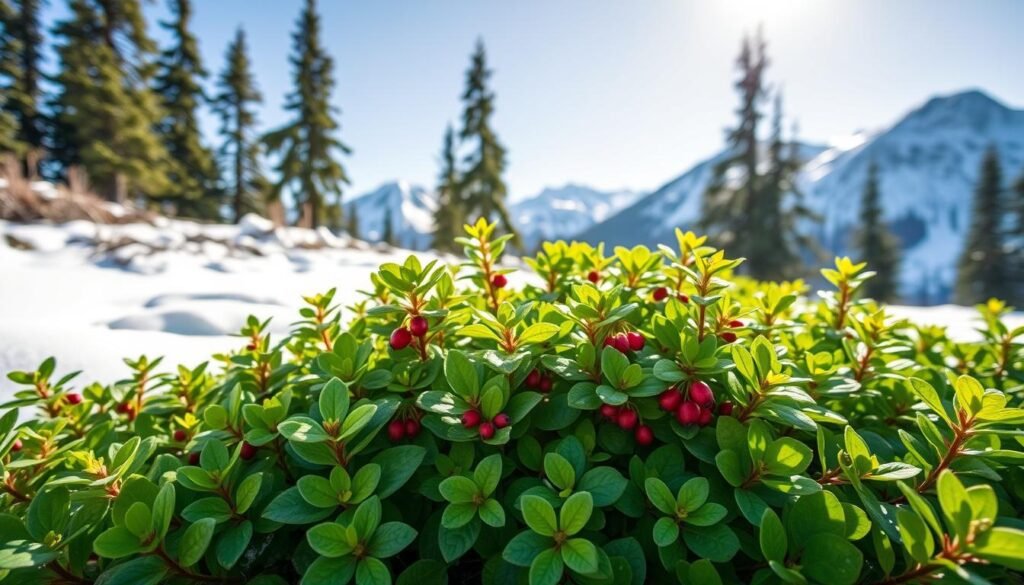
Edibility of Wintergreen Berries
Wintergreen berries, known as Gaultheria procumbens, have a unique taste. They are bright red and taste like mint. These berries are great to eat raw and can make many dishes better. Knowing how to eat wintergreen berries can make foraging in Alaska more fun.
Raw Consumption
Eating wintergreen berries raw is a treat. They taste sweet and minty. With sizes of 6-9 mm, they’re easy to spot. Animals like birds and mammals also enjoy them, showing how tasty they are.
In Recipes
Wintergreen berries can make your food better. They add color and flavor to salads, desserts, and jams. Their taste fits well with Alaskan dishes, making them versatile.
Dried Berries
Dried wintergreen berries are great for any time of year. They pack a strong flavor that can spice up dishes or make tasty teas. Even dried, alaska wild wintergreen berry edibility stays strong, offering a special taste all year.
Edibility of Wintergreen Leaves
Wintergreen leaves are not just pretty; they’re also good for you. In Alaska, they add a special flavor and health perks. You can use them to make herbal tea or add flavor to food.
The taste of wintergreen comes from methyl salicylate. This gives them a minty flavor. Cooking with them in Alaska lets you try new tastes. Used right, they can really boost your dishes.
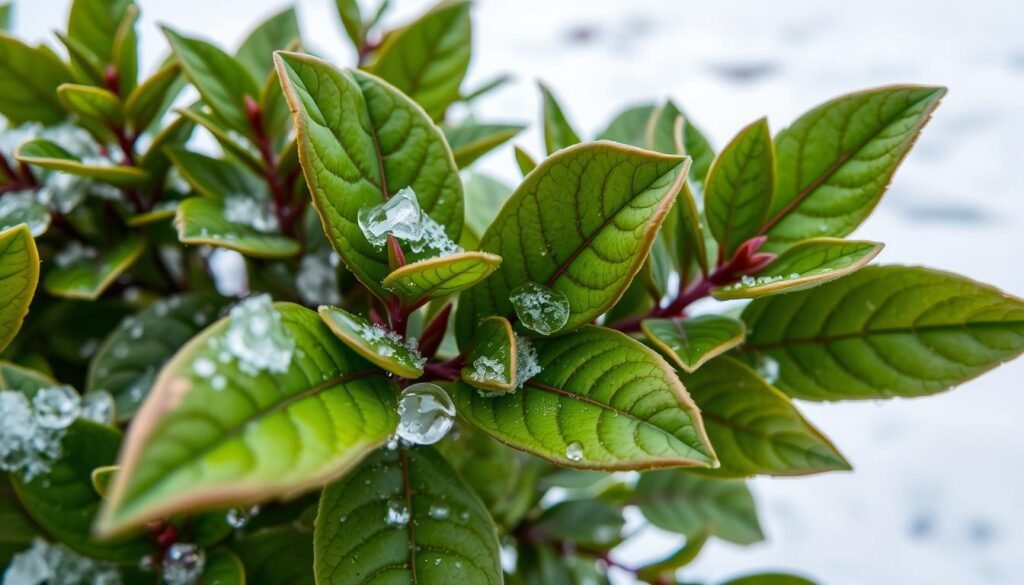
But, it’s important to use wintergreen leaves carefully. Eating too much can cause problems. It’s best to enjoy them in small amounts. Always check with experts if you’re not sure how much is safe.
There are many ways to use wintergreen leaves in Alaska. You can make tea, add them to salads, or use them in cooking. Their taste and health benefits make them a great addition to your kitchen.
Health Benefits of Wintergreen Plants
Wintergreen plants have been valued for centuries for their medicinal properties. They support health in many ways, thanks to their natural compounds. You might find the health benefits of wintergreen plants quite interesting.
Pain Relief
The main compound in wintergreen, methyl salicylate, helps with pain like aspirin does. It can be applied topically or made into tea to ease headaches and muscle pain. This makes wintergreen a good natural remedy for pain.
Digestive Health
Wintergreen tea can help with digestive problems. It may ease discomfort from gas and bloating, improving digestive health. Adding wintergreen plant medicinal benefits to your routine can boost your digestive health.
Respiratory Support
This plant helps with respiratory health by easing congestion and coughs. Its natural compounds offer a soothing effect. It’s a potential ally for those with respiratory issues.
Antioxidant Properties
Wintergreen berries are rich in antioxidants. They help reduce oxidative stress in the body. These properties can improve overall health and well-being, making them a great addition to a balanced diet.
How to Identify Wintergreen Plants in Alaska
To identify wintergreen plants in Alaska, look for certain features. They grow 4 to 6 inches tall, which is quite low. Their glossy dark green leaves and bright red berries are key signs.
The strong minty smell when you crush the leaves is a big clue. This smell is unique to wintergreen. In early summer, look for small white or pale pink flowers.
Wintergreen plants like moist woodlands and open area edges. Knowing this helps you find them. But, make sure you know what they look like to avoid mistakes.
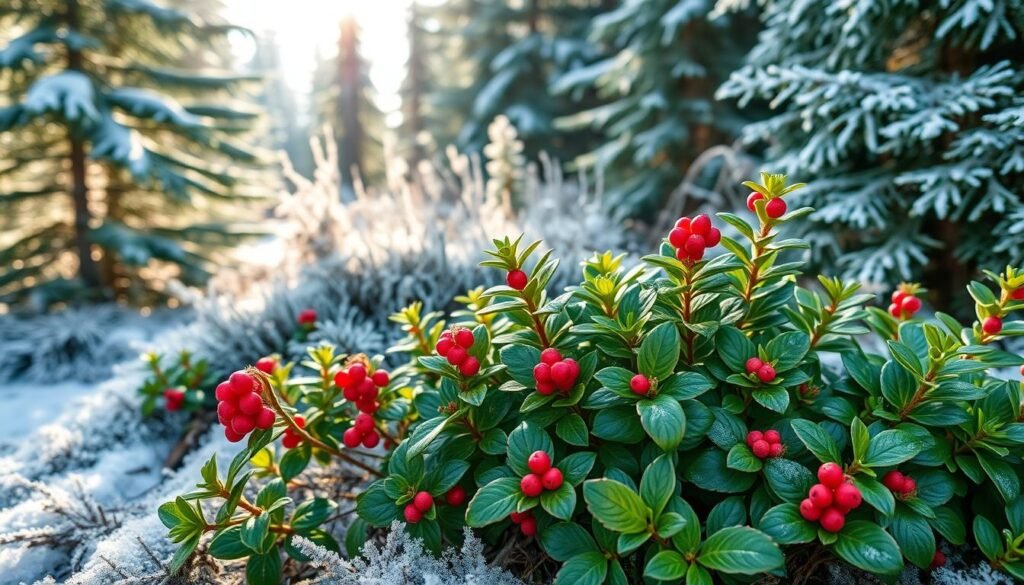
- Height: 4 to 6 inches
- Leaves: Glossy dark green
- Berries: Bright red
- Aroma: Minty scent when leaves are crushed
- Flowers: Small white or pale pink, appearing in early summer
Knowing these signs makes finding wintergreen plants in Alaska easier. With time, foraging becomes a fun part of exploring the outdoors.
How to Safely Consume Wintergreen Plants
Wintergreen plants are great for cooking and health, but you need to be careful. They are safe to eat, but following some rules is key. This is to avoid problems from methyl salicylate, a chemical in these plants.
To safely eat wintergreen plants, follow these steps:
- Berries: Try a few wintergreen berries, especially from Gaultheria procumbens. They taste like strong mint.
- Leaves: Add one or two leaves to your tea. It can help with headaches and sore muscles.
- Frequency: Don’t eat too much to avoid getting sick. Eating too much can cause problems.
- Children and Pets: Be careful around kids and pets. They can get sick from wintergreen more easily.
It’s important to know how to enjoy wintergreen safely. With careful eating, you can get its health benefits without risks.
How to Harvest Wintergreen Plants in Alaska
Harvesting wintergreen plants in Alaska requires knowing how to gather leaves and berries. These steps help keep the plants healthy for the future.
Harvesting Leaves
The best time to pick leaves is in late summer or early fall. The leaves are full of flavor and health benefits at this time. Use scissors or pruning shears to cut the leaves carefully.
Make sure not to harm the plant too much. Leave enough leaves to help the plant grow strong.
Harvesting Berries
Berries are ready to pick in late summer and can be gathered all winter. When picking berries, be gentle to avoid damaging the stems. Berries from Gaultheria procumbens have a strong minty taste.
They’re great for making teas, jams, and syrups. Harvesting berries the right way is key to keeping them coming back.
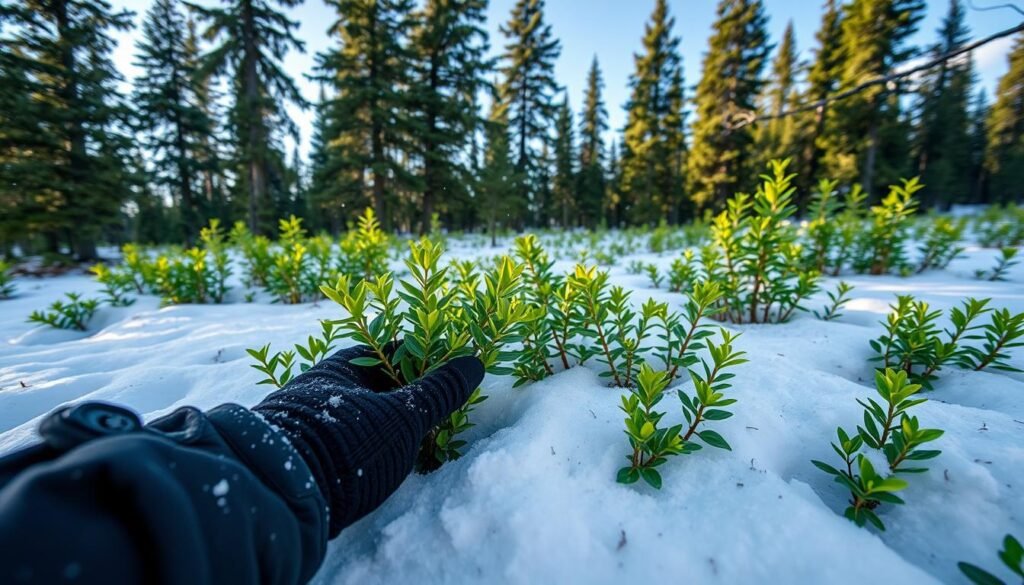
| Aspect | Harvesting Method | Best Time to Harvest |
|---|---|---|
| Leaves | Use scissors or pruning shears to snip leaves | Late summer to early fall |
| Berries | Gently pluck berries from the plant | Late summer to winter |
Cooking and Recipes with Wintergreen Plants
Cooking with wintergreen plants is a fun way to add flavor to your dishes. The unique taste of these plants makes them perfect for various recipes. Try making wintergreen berry jam for a sweet and tangy breakfast treat.
For a refreshing drink, try wintergreen-infused water. It’s easy to make and lets you enjoy wintergreen’s aroma while staying hydrated. If you love baking, add wintergreen berries to your muffins, cakes, or cookies. It’s a great way to make your baked goods stand out.
Wintergreen isn’t just for desserts. You can also use the leaves to season meats or dressings. It adds a minty freshness that’s perfect for many dishes. Exploring wintergreen recipes can turn simple meals into something special, making your cooking more exciting and flavorful.
Conclusion
Wintergreen plants in Alaska are not only tasty but also offer health benefits. Gaultheria procumbens, or Eastern teaberry, and its Alaskan cousin, Gaultheria hispidula, add a unique flavor to your meals. You can enjoy them raw, dried, or in recipes, making them a nutritious choice.
Before eating wintergreen plants in Alaska, make sure you know how to identify them safely. This way, you can pick them without harming the environment. Wintergreen plants also help Alaska’s wildlife, making them important for the ecosystem.
Using wintergreen plants in Alaska opens up a world of taste and health. As you try them in your cooking, think about the Indigenous people who have used them for centuries. They knew the value of these plants for food and medicine.

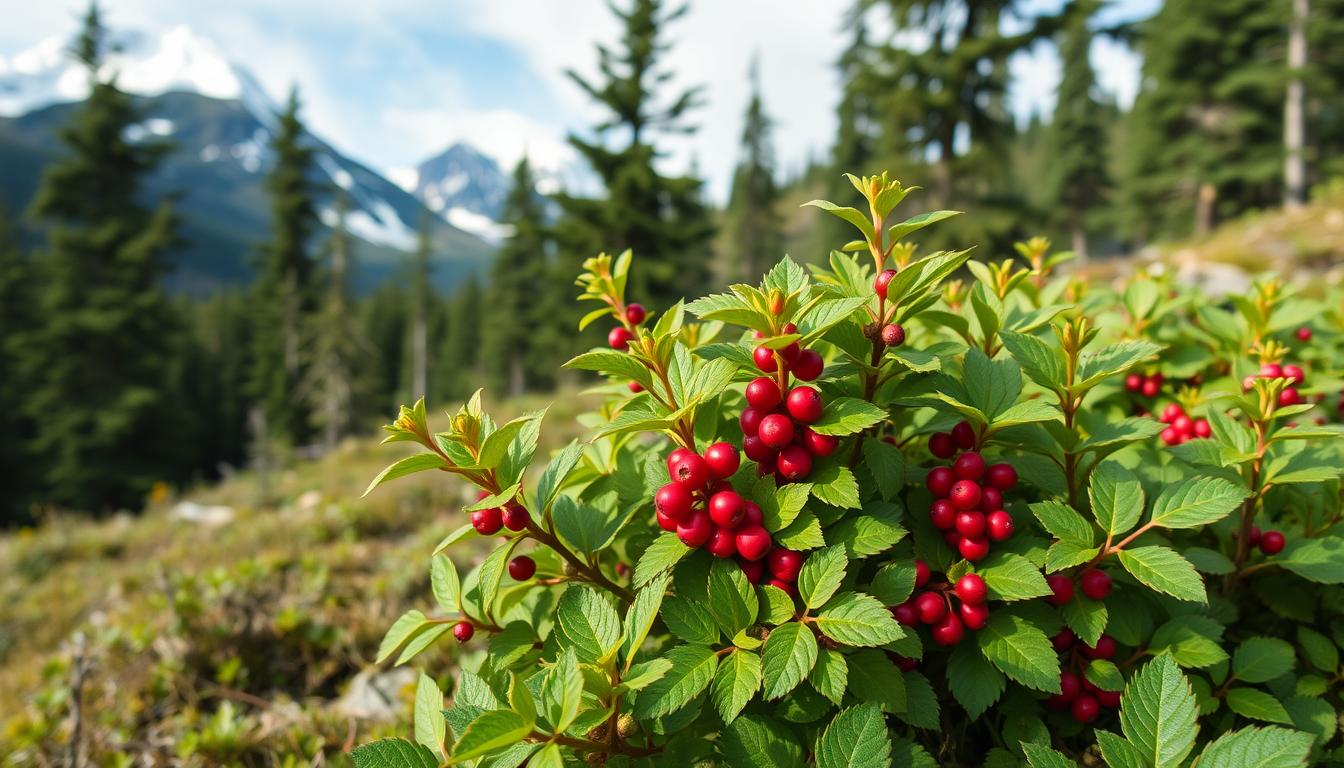

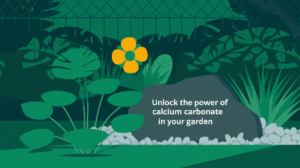
Pingback: is the wintergreen found in alaska edible